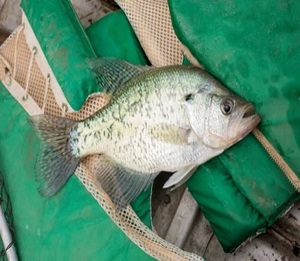Finding the crappie on the fish finder can be difficult if you do not know what to look for. Crappies are one of the easiest to catch fish, and they usually form large schools. The best time to look for the crappies is in the summer when the water is warm. Fishfinders can be used to locate and find these fishes more efficiently than just trying luck here and there.
If you know the exact settings of the fish finders best suited for crappie fishing, you can easily find them without much effort.
Table of Contents
How To Find Crappie On Fish Finder
Sonar is the device that sends the sound wave into the water, and the feedback is noticed and displayed on the surface. It may seem like a simple procedure, but you can configure it to your requirements. First, set the following settings on the fish finder if you really want to find crappie.
Depth
Crappies are usually found below 10 feet of water, so the best strategy when looking for them is to set the upper range of the fish finder to 10 feet. Most modern fish finders have this capability, and you can select the upper and lower depth of the scan. The preferred lower depth for finding the crappie is 30 feet.
The reason is that crappies are usually 4 to 8 inches in size, and when you select the large area for scanning, the pixels drop, and it gets easier to miss the smaller fishes as there are fewer pixels for unit depth. Setting the 10 to 30 feet of scan area is the preferred area. Lower than 30 feet is not recommended as it is not easy to pull up from there, so it is a waste.
Sensitivity And Speed
It is best to set the fish finder’s sensitivity to 10 for the best chances of finding them on the fish finder. The boat’s speed also matters because driving the boat too fast may result, a miss in the scanning of some areas. The optimum speed is about 3 mph, and you would get the complete image below the surface activities.
The Resolution Of Scan
Set the resolution properly as it is the most crucial part in finding crappie.Keep in mind , the 2D fish finder will only cover about 10 feet of area, which means that you would only see the 5 feet left and right of the boat. For the complete scan of the site,you have to take a few turns so that you will not miss a spot.
How Crappie Look On Fish Finder
Crappies prefer to swim in school so that you will see the strong reflection on the fish finder screen. The crappies are indicated as the sonar readings adjacent to the brush pile. The brush pile is the solid red color imaging, and you can see the structure of elongated arches that are red at the center and blue or yellow in the corner, indicating the school of the fish.The most common interpretation is the arches stacked up vertically on the side of the brush pile.
Where To Look For Crappie
Crappies are medium-sized fish that are usually 4 to 8 inches in size. They prefer to live near the structures and form large groups that make them easier to locate and find by the anglers. The crappies look like arches or stripes on the fish finders and can be distinguished as the fish finder’s screen also makes brush piles. Challenging bottom areas next to the deeper waters are the ideal places to look for crappies. If you find them in colder seasons, try deeper water as they prefer warm water and go deep.
Conclusion
Finding the crappie is not so complicated, and it is one of the easiest fish to find using the fish finder. Most of the time, the anglers fail to match the resolution, speed, and scanning area of the fish finder, which results in a lack of accuracy in finding the fish. The best strategy to find the crappies is to set the fish finder scanning area between 10 to 30 feet, and if the upper limit is not available, you select to leave it at zero with the optimum speed of the boat is about three mph.
- What Do You Need for Fishing - August 18, 2022
- How to Find Offshore Fishing Spots - August 18, 2022
- What to Use for Trout Fishing - August 17, 2022

